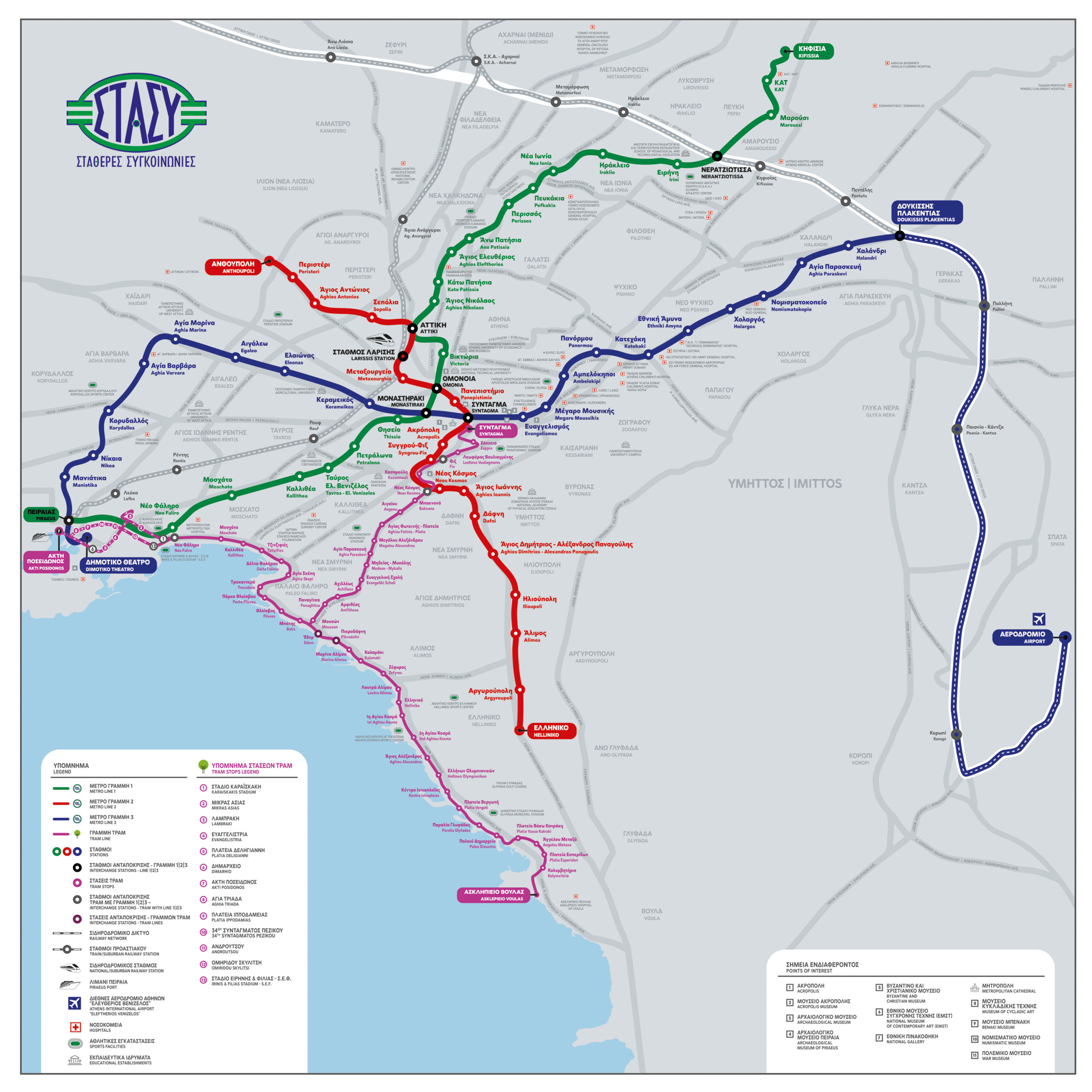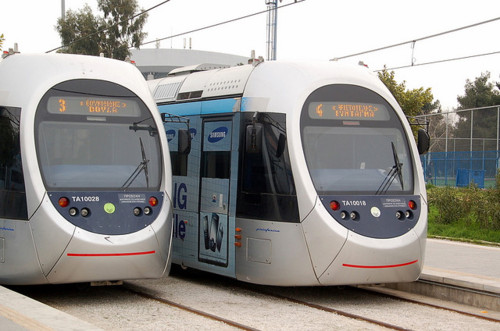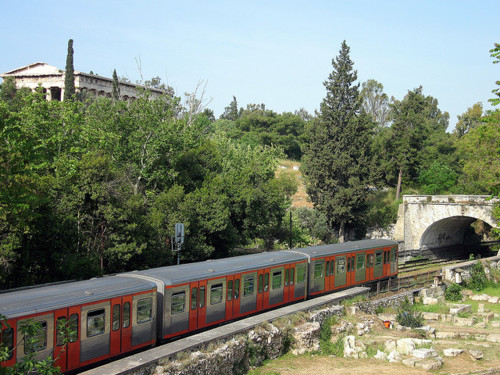Athens Transport Tickets & Cards |
How to get to the airport and the port of Athens |
20 places to visit in Athens and how to get there |
Last updated: December 15th, 2022
As of December 2022 (will be updated, if needed):
- Passengers are required to wear face masks/coverings while using Athens Transport or waiting at stations. Passengers should wear either one FFP2/KN95/N95 mask or a double mask (one simple medical masks and a cloth mask)
- Bus passengers cannot use the front door to get on or off the bus.
Welcome to Athens! With an urban population of more than 4 million people, Athens is the capital of Greece and the 4th most populous capital in the E.U. with a large, modern mass transit system to serve the needs of residents and visitors. It consists of:
- City buses
- Electric trolley-buses
- Athens Metro
- Athens Tram, and
- Athens Suburban railway.
Athens is connected to even the remotest destinations through the Athens International Airport, ports of Piraeus, Rafina and Lavrio, national railway network operated by Hellenic Train and, long-distance bus network KTEL.
From the airport (and the port) to downtown Athens

You’ve just arrived in Athens by plane or by boat. How will you get downtown? Where will you buy tickets and how much will they cost? Find all the information you need here:
Moving around the city
Buses and trolleys
 A typical Athens bus
A typical Athens bus
City buses and electrical trolley-buses serve Athens and its suburbs. All vehicles are air-conditioned although most of them have started showing their age. Special schedules apply during summer months of July-September
Operating hours vary according to line/day/season, but generally they run between 5:00 a.m. – midnight. There are also five 24-hour lines, 4 airport lines (see above section), and 8 Express lines.
You can find routes, maps and real time bus movement information for every line on this website as well as the app ‘OASA Telematics’ for Android and iOS. You can also get additional information by calling 11185 from a Greek phone. For ticket info see Athens Transport tickets and cards.
Metro

The Athens Metro has 3 lines. Line 1 (the Green line) started operation in 1869, making it the second oldest underground system in the world after the London Underground. Lines 2 and 3 opened in 2000 and increased the Metro’s popularity due to its speed, cleanliness and security. Today’s Athens underground connects important landmarks of the Greek capital, such as the Acropolis, Athens Airport, Port of Piraeus, Central Railway Station and Olympic Stadium, in addition to connecting downtown Athens with the suburbs. Archaeological exhibits found during Metro’s construction and modern works of art are exhibited in many stations. All stations are fully accessible to disabled persons with elevators in every level and platform and most of the trains are air-conditioned.
- Line 1 (green line): Kifisia – Piraeus
- Line 2 (red line): Anthoupoli – Eliniko
- Line 3 (blue line): Airport – Douk. Plakentias – Dimotiko Theatro (Piraeus)
All trains stop at all stations all the time, except of the section Airport – Douk. Plakentias of line 3 where trains run every 30 minutes (this section is shared with the Suburban Railway).
Operating hours are 5:30 a.m. to 00:30 a.m., and every Friday and Saturday night, lines 2 & 3 stay open until 1:30 a.m. You can find information about Athens metro, including timetables, maps, parking and safety information on this website. For ticket info see Athens Transport tickets and cards.
Attention: Due to several cases of pickpocketing inside the Metro system during the last years, you are advised to be constantly aware of your belongings and your pockets, especially in central stations and inside trains.
Tram

Starting operation on the eve of Athens’ Olympics, the Athens Tram connects the city center with the southern seaside. There are 3 lines:
- Line 1 “Syntagma – SEF” linking downtown Athens to the Peace and Friendship Stadium,
- Line 2 “Syntagma – Voula” which runs between the city center and southern suburb of Voula and
- Line 3 “Voula – SEF” running along the coastal zone.
In summer, many Athenians choose the tram to visit nearby beaches, seaside cafes and clubs.
Operating hours are 5:30 a.m. to 00:00 a.m. and on Fridays and Saturdays it operates approximately from 5:30 a.m. to 1:30 a.m. Information on the Athens Tram, including timetables, can be found on on this website. For ticket info see Athens Transport tickets and cards
Suburban Railway
The Suburban Railway, or “Proastiakos”, is part of the national railway network of Greece and is operated by private company Hellenic Train.
Its 3 main routes are Piraeus – Athens Central Station (Larissa station) – Airport, Piraeus – Athens Central Station – Kiato and Athens Central Station – Halkida. There are also extra trains between Ano Liosia and Airport station as well as Ano Liosia and Peania stations.
Be aware that different fares apply: the standard 90-minute ticket for the Athens region covers all Proastiakos journeys from Piraeus to SKA and Magoula to Koropi stations, while different fares are charged for more distant stations. See also: Suburban Railway discount policy.
Ath.ena Tickets and Ath.ena Cards are accepted within the urban section of Proastiakos as well as for journeys from/to the airport. Tickets for Proastiakos can be bought at all Proastiakos stations. More information on the Hellenic Train website.
Current Proastiakos timetables:
- Airport – Athens – Piraeus,
- Piraeus – Athens – Airport,
- Piraeus – Athens – Kiato & Kiato – Athens – Piraeus,
- Athens–Halkida–Athens,
Taxis
Taxis (yellow in Athens, while other colors are preferred elsewhere in Greece) can be a more convenient -although pricier- mean of transportation. While many taxi drivers are excellent professionals, it is believed that some of them try to gain more by opting for the longest route when their passenger (Greek or non Greek) is not familiar with their destination.
Taxi drivers in Athens are required by law to always use a taximeter and issue a receipt at the end of the journey. You can remind your driver to do so in case they don’t turn on their taximeter. There is also an official list of fares and surcharges they must follow. On the islands and elsewhere around Greece, fares are usually subject to agreement at the beginning of the journey.
Long-distance transportation

Long-distance buses (KTEL)
KTEL buses are privately owned bus networks based in every prefecture/island of Greece and often are the most affordable and convenient means of transport, though the quality of service can vary. Detailed information on routes, timetables, ticket fares and practical information can be found at livingingreece.gr.
Greek Railways
Hellenic Train is the only long-distance passenger railway company in Greece. Formerly state-run, from 2017 it belongs to the Italian State Railways. Today most traffic is concentrated on the Athens – Thessaloniki line and the suburban network in Athens, Thessaloniki and Patras. There are also limited international routes to Sofia, Skopje and Belgrade. Information and ticket sales on the Hellenic Train website.
Ticket information
At Athens Transport Tickets & Cards you can find everything you need to know in order to issue and use the right ticket when riding Athens Transport
- Looking for places to visit in Athens, Greece? Check out: 20 places to visit in Athens, Greece and how to get there
Information resources

Keep in mind that strikes in Greece occur regularly and many times affect transportation even though most times there is an alternative option. Strike schedules are sometimes announced just 1-3 days in advance, so it’s essential to stay informed. We will try to update the top right of this page in both English and Greek when we have new strike information. For information about Athens transport routes, schedules and more, you can also call 11185 on a Greek phone.
If you can read Greek, you may follow my twitter account @athenstransport for more timely information.
Suggested Websites:
- Athens Urban Transport Organisation – Bus and trolley routes, tickets, general information
- Urban Rail Transport Authority – The official website for Athens Metro and Tram
- Athena Card – The website of the new electronic ticket system
- Athens International Airport
- City of Athens – official website
- Breathtaking Athens – City of Athens’ official visitors’ website
- Visit Greece – Greek National Tourism Organisation
More information
- Athens Transport Tickets and Cards: Information about fares and tickets for Athens Transport
- How to get to the Athens airport and the port: All the information you need about how to travel between the Athens airport (and the port of Piraeus) and the center of Athens using public transport
- Looking for places to visit in Athens, Greece? Check out: 20 places to visit in Athens, Greece and how to get there
About this website: AthensTransport.com is a non-for-profit information website, not affiliated with any Athens transportation organization or other local or national government entity. Since 2009 we try to offer accurate information to Athenians and visitors alike. If the above information was useful to you, you may donate a small amount via Paypal
Have a question? Do you think more information should be added to this page? Feel free to leave a comment below or contact me via Twitter!
Information on this page comes from websites linked above and personal experiences as an Athenian, blogging about transportation in my city. Photos and maps via 1 | 2 | 3 | 4 | 5 | 6 | 7 | 8 | 9
This work is licensed under a Creative Commons Attribution-ShareAlike 3.0 Greece License

